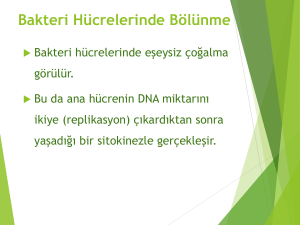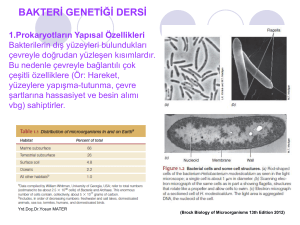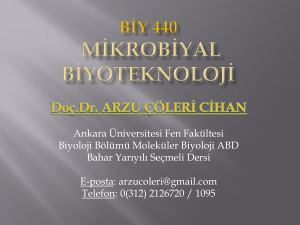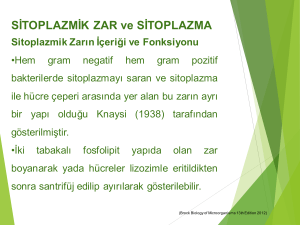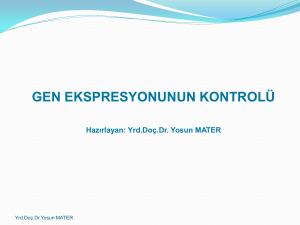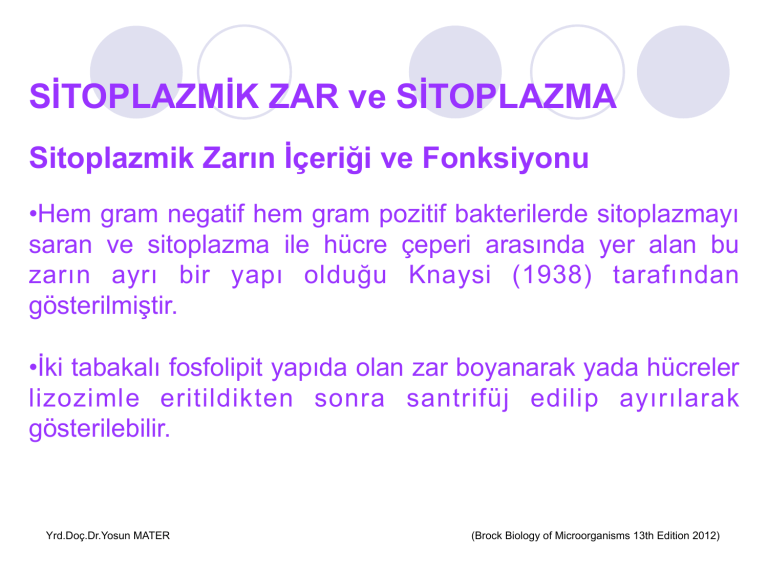
SİTOPLAZMİK ZAR ve SİTOPLAZMA
Sitoplazmik Zarın İçeriği ve Fonksiyonu
• Hem gram negatif hem gram pozitif bakterilerde sitoplazmayı
saran ve sitoplazma ile hücre çeperi arasında yer alan bu
zarın ayrı bir yapı olduğu Knaysi (1938) tarafından
gösterilmiştir.
• İki tabakalı fosfolipit yapıda olan zar boyanarak yada hücreler
lizozimle eritildikten sonra santrifüj edilip ayırılarak
gösterilebilir.
Yrd.Doç.Dr.Yosun MATER
(Brock Biology of Microorganisms 13th Edition 2012)
Glycerol
O
H
C O C H
O
C O C H
H3C
H 3C
Fatty acids
O
H C O P O–
H
(a)
UNIT 1
ctures occasionally observed
look” like bacterial cells are
, many very small prokaryeen grown in the laboratory.
in 104–105 prokaryotic cells
ry small cells, 0.2–0.4 !m in
pathogenic bacteria are also
ese pathogens are examined,
ned and missing many genes
m by their hosts.
O
Phosphate
CH2
Ethanolamine
CH2
+NH
3
ses as cells become
Hydrophilic
region
enetics of prokaryotes
Fatty acids
Membrane
embrane
n barrier that surrounds the
m the cell’s environment. If
Yrd.Doç.Dr.Yosun
MATER
y of the cell
is destroyed,
the
nt, and the cell dies. We will
Hydrophilic
region
(b)
Fatty acids
Glycerophosphates
G. Wagner
nd function of a critical cell
membrane. The cytoplasmic
among them as the “gateexit the cell.
Hydrophobic
region
(c)
Figure 3.4
Phospholipid bilayer membrane. (a) Structure of the
phospholipid phosphatidylethanolamine. (b) General architecture of a
bilayer membrane; the blue balls depict glycerol with phosphate and (or)
other hydrophilic groups. (c) Transmission electron micrograph of a membrane. The light inner area is the hydrophobic region of the model membrane shown in part b.
(Brock Biology of Microorganisms 13th Edition 2012)
52
UNIT 1 • Basic Principles of Microbiology
Out
Phospholipids
Hydrophilic
groups
6–8 nm
Hydrophobic
groups
In
Integral
membrane
proteins
Phospholipid
molecule
Figure 3.5
Structure of the cytoplasmic membrane. The inner surface (In) faces the cytoplasm and the
outer surface (Out) faces the environment. Phospholipids compose the matrix of the cytoplasmic membrane
with proteins embedded or surface associated. Although there are some chemical differences, the overall
structure of the cytoplasmic membrane shown is similar in both prokaryotes and eukaryotes (but an exception to the bilayer design is shown in Figure 3.7e).
other
proteins, called
peripheral membrane proteins, are not
Yrd.Doç.Dr.Yosun
MATER
membrane-embedded but nevertheless remain firmly associated
with membrane surfaces. Some of these peripheral membrane
point inward from
eachBiology
glycerol
molecule are covalently
(Brock
of Microorganisms
13th Editionlinked.
2012)
This forms a lipid monolayer instead of a lipid bilayer membrane
(Figure 3.7d, e). In contrast to lipid bilayers, lipid monolayer
Besin maddelerinin taşınması:
• En önemli özelliği “yarı-geçirgen” (=semi-permeable) olmasıdır.
Bu özelliği ile hem ozmotik bir baraj hem bir köprü olarak iş
görür. Çevrede yer alan çoğu molekül sitoplazmik zarda yer alan
lipit tabakaları doğrudan geçemezler. Taşıma proteinleri denilen
ve çift tabakalı fosfolipit tabakayı boydan boya geçen proteinler
yardımıyla şeker ve diğer besin maddeleri sitoplazmaya
geçerler; besin ve enerji kaynağı olarak kullanılırlar.
• Bakteriler zaman zaman zararlı maddelerinde geçişine izin
verebilirler. Bunun sebebi taşıma proteinlerinin bir veya birkaç
bileşeni özellikle tanımasıdır.
• Genellikle bakteri içindeki madde yoğunlu canlının bulunduğu
çevredeki madde yoğunluğundan fazladır bu nedenle hücre
içine madde alınımında enerji harcanır.
Yrd.Doç.Dr.Yosun MATER
(Brock Biology of Microorganisms 13th Edition 2012)
Enerji mekanizması ve elektron taşıma sistemi:
• Bakterilerde hücre zarı, hücrenin enerji mekanizmasında
önemli bir role sahiptir.
• Sitoplazmik zarda yer alan enzimler ve diğer moleküller
proton pompaları yardımıyla çalışırlar. Bu proteinler ve bu
sistemde yer alan diğer moleküller elektron taşıma sistemi
adını alır. Çünkü elektronlar protonlardan ayrılır ve sitoplazmik
zarın dış yüzeyinde birikirler. Karmaşık protein yapılı terminal
elektron yakalayıcıları ATP sentaz’lar bu elektronları yakalar ve
yeniden hücre içine alır. ATP hücrenin temel enerji kaynağıdır.
Bu enerji kirpik motorlarının çalıştırılması ve dışarıdan hücre
içine madde alınmasında kullanılır.
• Bu zar ökaryotlarda mitokondri zarlarına benzer bir görev
yapmaktadır ve suya ilgisi azdır.
Yrd.Doç.Dr.Yosun MATER
(Brock Biology of Microorganisms 13th Edition 2012)
• Bakteri hücre çeperi ve hücre zarının kuru ağırlıktaki oranı
%20 kadardır. Bunun nedeni bakterilerin iç basınçlarının çok
yüksek olmasıdır. İç basınçları %10-20’lik sakaroz çözeltisine
eşittir.
• Bu nedenle ancak sağlam bir hücre zarı ve hücre çeperi
yardımıyla kendilerini patlamaktan koruyabilirler. Hücre
çeperleri oluşturması engellenen bakteriler genellikle küre
biçiminde hücrelere yani protoplastlara dönüşürler.
• Eğer bakteri hücrelerinin etrafında hücre çeperi kalıntıları
bulunuyorsa bu durumda bakterilere sferoblast adı verilir.
Bunların etraflarında hücre zarları vardır.
Yrd.Doç.Dr.Yosun MATER
(Brock Biology of Microorganisms 13th Edition 2012)
Sitoplazmik zar ve peptidoglikan sentezi:
• Sitoplazmik zarda yer alan proteinler, peptidoglikan
sentezi ve devrinde de rol oynarlar. Bakterilere uzama
ve bölünme emri geldiğinde, peptidoglikanda kırılma
meydana gelip yeniden uzatılarak yapılandırılır.
• Sitoplazmik zar proteinleri bu kırılma ve yeniden
yapılanma aşamasında yardım ederler.
• Ayrıca antibiyotik bağlayan proteinlerde burada yer
alır. LTA ve LPS sitoplazmik zara bağlıdır.
Yrd.Doç.Dr.Yosun MATER
(Brock Biology of Microorganisms 13th Edition 2012)
Salınım sistemi:
• S itoplazmik zarda yer alan proteinler salgılanmış
proteinlerdir. Sitoplazmada yapılırlar ve periplazma içine
salınırlar. Bu karmaşık proteinlerden oluşan sisteme salgı
sistemi adı verilir.
• Bakteriler ürettikleri bütün proteinleri salgılamak istemezler.
Bazılarını periplazmada tutarlar, bazılarını dış çevreye
salarlar.
• Bu tutulan proteinleri amino uçlarında yer alan kısa amino
asit sırasının varlığına bakarak belirleyebiliriz.
• Bu kısa parça kesilip uzaklaştırıldığında protein salınır.
Yrd.Doç.Dr.Yosun MATER
(Brock Biology of Microorganisms 13th Edition 2012)
Düzenleyici proteinler:
• Bakterilerin sitoplazmik zarı kısmen beyin gibi de görev alır.
• Çünkü burada yer alan bazı duyusal proteinler hücrenin
dışındaki çevre şartları ile ilgili değişiklikleri hücre içine iletirler.
• Bu şekilde hücre dışarıda algıladığı durumlara bağlı olarak
hücre içinde ve dışında uygun düzenlemeler yapılır. Ör: insan
sindirim sistemine giren bir bakteri ortama hemen tutunması
gerekir bu nedenle hemen pili üretir ve o bölgeye tutunur.
• Bu düzenleyici proteinler yalnız sitoplazma zarında yer almaz
hücre içinde de yer alır. Bu düzenlemelerin tam anlamıyla
yapılabilmesi için hem sitoplazma zarı hem de hücre içinde yer
alan düzenleyici proteinlerin birlikte çalışması gerekir.
Yrd.Doç.Dr.Yosun MATER
(Brock Biology of Microorganisms 13th Edition 2012)
SİTOPLAZMA
• Bakteri hücrelerinin sitoplazmasında yer alan enzimler yardımıyla glukoz ve
diğer karbon kaynakları okside edilerek doğrudan ATP elde edilir.
• Bu enzimlerden bazıları sitoplazmik zarda yer alan elektron taşıma sistemi
yardımıyla dolaylı olarak ATP elde edilmesinde görev alır.
• Buna ek olarak zaman zaman bakterilerde yer alan hücre içinde zar
katlanmaları şeklinde gözlenen ve mezozom adını alan, hem enerji eldesin
de hem de gaz alış verişinde görev aldığı düşünülen yapılardır. Fotosentetik
bakterilerde fotosentezden sorumlu pigmentler vardır. Bunlarda yine
mezozomların üzerinde yer alırlar.
• Peptidoglikan tabakanın alt birimleri sitoplazmada hazırlanır ve son
birleştirme aşamasında periplazmik alana geçerler. Yine bazı yedek
maddeler (Ör: poly- β hidroksibütirik asit granülleri) sitoplazma içinde
granüller halinde depo edilebilirler.
Yrd.Doç.Dr.Yosun MATER
(Brock Biology of Microorganisms 13th Edition 2012)
Ribozomlar:
• Sitoplazmada serbest halde yer alırlar. Mezozom benzeri zar katlanmalarına
tutunmuş olarak ta görülebilirler.
• Bakteri hücrelerinde yer alan RNA’nın %80’den fazlası ribozomlarda yer alır.
• Prokaryotlardaki ribozomlar hemen hemen küresel yapıda görünürler. 200Å
çapında, 70S çökelme sabitine sahiptirler. Alt birimleri 50S ve 30S’ten oluşur.
Bakteri genetik materyali:
• Hücrenin genetik bilgilerini içeren DNA (=Nukleoid) ve onunla bağlantı
halinde bulunan proteinlerde sitoplazmada yer alır.
• E.coli bakterisi DNA’sı yaklaşık 1 mm boyunda olduğu ve 3 µm boyundaki
bakterinin içine bu DNA’nın sığması için sıkıca paketlendiği belirlenmiştir.
Yrd.Doç.Dr.Yosun MATER
(Brock Biology of Microorganisms 13th Edition 2012)
10 µm
(b) Eukaryote
tion and carry out respiration and photosynthesis, respectively.
In contrast to eukaryotic cells, prokaryotic cells have a simpl
internal structure in which organelles are absent (Figures 2.11
Figure 2.11
Internal structure of cells. Note differences in scale and
internal structure between the prokaryotic and eukaryotic cells.
Eukaryote
(a) Bacteria
R. Rachel and K.O. Stetter
John Bozzola and M.T. Madigan
Cytoplasmic
membrane
(b) Archaea
Nucleus
Cell
wall
Mitochondrion
S.F. Conti and T.D. Brock
Prokaryotes
(c) Eukarya
Figure 2.12
Electron micrographs of sectioned cells from each of the domains of living organisms.
(a) Heliobacterium modesticaldum; the cell measures 1 * 3 !m. (b) Methanopyrus kandleri; the cell measures
0.5 * 4 !m. Reinhard Rachel and Karl O. Stetter, 1981. Archives of Microbiology 128:288–293. © SpringerVerlag GmbH & Co. KG. (c) Saccharomyces cerevisiae; the cell measures 8 !m in diameter.
Yrd.Doç.Dr.Yosun MATER
(Brock Biology of Microorganisms 13th Edition 2012)
UNIT 3 • Molecular Biology and Gene Expression
D
C
B
A
158
M
B
E
g
ar
I
100/0
HfrH
P804
10
90
ar
ori gX
C
312
4333
4082
4046
4005
malS
80
gal
678
787
Not1 restriction
sites, in kbp
3801
mal
Escherichia coli K-12
pyrD
1157
1252
argD
rpsL
purB
umuD
1350
trp
30
70
argR
argG
1620
A
B
C
D
E
KL14
2523
2782
C
tol
60
sa
d
an
A
argW
G
D
C
B
H
A
F
I
E
gyrA
hisS
S
his
rec
A
arg
V
gA
m
40
feo
th
y
trp operon
(tryptophan
biosynthesis)
arg
ar
2050
50
argT
The chromosome of
1875
Hfr44
A
ar
Yrd.Doç.Dr.Yosun MATER
2011
2513
2309
gP
Figure 6.10
20
T
E
942
gor
T
P
Q
K
HfrC
25
spoT
ar
gU
lac
C
l
ma
B
argF
rA
H
A
lex
uv
G
argI
A
Y
Z
thr
dnaK
leu
K
E
F
Origin of
replication
lac operon
(lactose
degradation)
his operon
(histidine
biosynthesis)
(Brock Biology of Microorganisms 13th Edition 2012)
locus. Replication proceeds bidirectionally from
would add an extra 48.5 kbp (slightly over 1 min)
Single strands
• B a k t e r i D N A ’ s ı
nukleoid bölgede iki
şekilde, katlanmış ve
katlanmamış (açık)
olarak bulunurlar.
Melting
1.0
C
A
T
A
C
G
T
G
T
A
T
G
C
A
1.2
G
T
A
T
G
C
A
C
A
T
A
C
G
T
Tm= 85.0°
C
G A
T T
A A
T C
G G
C
T
A
(a) Relaxed, covalently closed circular DNA
Break one strand
Seal
Nick
Double
strand
• DNA’nın çok sıkı bir
şekilde °Ckendi üzerine
e 6.7 Thermal denaturation of DNA. DNA absorbs more ultraviation at 260
knmaasttheldouble
a nhelixdis ıdenatured.
ğ ı Theştransition
ekil
abrupt, and the temperature of the midpoint, T , is proportional
C content of the DNA. Although the denatured DNA can be
ü thepprocess
e does
r notsfollowa a similar
r m
d by slow s
cooling,
curve.a l
ation becomes progressively more complete at temperatures well
e T and (=supercoil)
then only after a considerable incubation
time.alır.
adını
0.8
72
76
80
84
88
92
96
m
(b) Relaxed, nicked circular DNA
Break one strand
Rotate one end of broken
strand around helix and seal
m
uiz
Yrd.Doç.Dr.Yosun
does antiparallel
mean inMATER
terms of the structure of doubleded DNA?
(c) Supercoiled circular DNA
(Brock Biology of
Microorganisms 13th Edition
2012)
when used to refer to two
eannealing, and hybridization as
• Bu tip katlanma bakteriler
NA adına
melt at higher
temperatures
oldukça
önemlidir.
Bazen bakterilerde histon
benzeri proteinler yer alır
ve DNA’ya tutunurlar ve
N A ’ n ı n would
b u beyover
apıyı
coli D
chromosome
s longer
coli
k o rthan
u mthe
a sE.ı n
a cellyitself.
ardım
uchederler.
DNA into such a little space?
of a “higher-order” structure on
-stranded DNA is further twisted
• DNA
sentezinde
yer alan
Figure
6.8 shows
how supercoile nIfzaicircular
m l e r DNA
v e molecule
R N A’ d a
uplex.
is sitoplazmada
lost and the DNA
yerbecomes
alır.
A molecule has exactly the numed from the number of base pairs.
molecule under torsion, much like
and that occurs when it is twisted.
her a positive or a negative manthe double helix is overwound,
g the double helix is underwound.
hen theYrd.Doç.Dr.Yosun
DNA is twisted
about its
MATER
Proteins
Supercoiled
domain
(d) Chromosomal DNA with supercoiled domains
Figure 6.8
Supercoiled DNA. (a–c) Relaxed, nicked, and supercoiled
circular DNA. A nick is a break in a phosphodiester bond of one strand.
(d) In fact, the double-stranded DNA in the bacterial chromosome is
arranged not in one supercoil but in several supercoiled domains, as
shown here.
(Brock Biology of Microorganisms 13th Edition 2012)
280
UNIT 4 • Virology, Genetics, and Genomics
IS3
Tn1000
Plazmitler:
99.2kbp/0
tra
region
• Birçok bakteri türünde normal
bakteri genomundan farklı olarak
sitoplazmada yer alan dairesel
DNA yapılarına plazmit adı verilir.
• B unlar toksin yapımı, genetik
madde aktarımı, antibiyotiklere
direnç, farklı antijenik özellikleri ve
daha birçok özelliği taşıyan özel
yapılardır.
• Bakteri genetiği çalışmalarında
sıklıkla kullanılan çok önemli
yapılardır.
Yrd.Doç.Dr.Yosun MATER
IS3
IS2
75 kbp
F plasmid
25 kbp
oriT
50 kbp
oriV
Figure 10.16
Genetic map of the F (fertility) plasmid of Escherichia
coli. The numbers on the interior show the size in kilobase pairs (the
exact size is 99,159 bp). The region in dark green at the bottom of the
map contains genes primarily responsible for the replication and segregation of the F plasmid. The origin of vegetative replication is oriV. The
light green tra region contains the genes needed for conjugative transfer.
The origin of transfer during conjugation is oriT. The arrow indicates the
direction of transfer (the tra region is transferred last). Insertion sequences
are shown in yellow. These may recombine with identical elements on the
bacterial chromosome, which leads to integration and the formation of
different Hfr strains.
(Section 10.13) that allow
the plasmid to integrate into the host
(Brock Biology of Microorganisms 13th Edition 2012)
chromosome. In addition, the F plasmid has a large region of
by cell-to-cell
are conjugative.
of genes on the
e genes encode
cation and othlasmid possessromosome, the
A, which may be
10.10).
between closely
gative plasmids
his means that
gram-negative
tween distantly
been shown to
sitive Bacteria,
n Bacteria and
endently in the
important evomid recombine
Yrd.Doç.Dr.Yosun MATER
Table 6.2 Examples of phenotypes conferred
by plasmids in prokaryotes
Phenotype class
Organismsa
Antibiotic production
Streptomyces
Conjugation
Wide range of bacteria
Metabolic functions
Degradation of octane, camphor,
naphthalene
Degradation of herbicides
Formation of acetone and butanol
Lactose, sucrose, citrate, or urea
utilization
Pigment production
Gas vesicle production
Resistance
Antibiotic resistance
Resistance to toxic metals
Virulence
Tumor production in plants
Nodulation and symbiotic nitrogen
fixation
Bacteriocin production and resistance
Animal cell invasion
Coagulase, hemolysin, enterotoxin
Toxins and capsule
Enterotoxin, K antigen
Pseudomonas
Alcaligenes
Clostridium
Enteric bacteria
Erwinia, Staphylococcus
Halobacterium
UNIT 3
on, a function
lves cell-to-cell
Wide range of bacteria
Wide range of bacteria
Agrobacterium
Rhizobium
Wide range of bacteria
Salmonella, Shigella, Yersinia
Staphylococcus
Bacillus anthracis
Escherichia coli
(Brock Biology of Microorganisms 13th Edition 2012)
antibiotics.
needed for
sul
immunity o
IS1
str
mids or tr
species of o
94.3/0 kbp
colicins; Yer
cat
The Col
mids can
IS1
released fro
75 kbp
25 kbp
surface of s
cally protei
tors or mic
50 kbp
tra
Colicins kil
colicins for
IS10
sium ions a
IS10
generate en
and degrad
Tn10
oriT
tet
endonuclea
that cuts at
Figure 6.12 Genetic map of the resistance plasmid R100. The inner
ribosomes.
circle shows the size in kilobase pairs. The outer circle shows the location
of major antibiotic resistance genes and other key functions: mer, merThe bacte
curic ion resistance; sul, sulfonamide resistance; str, streptomycin resisteria are qui
tance; cat, chloramphenicol resistance; tet, tetracycline resistance; oriT,
by plasmids
origin of conjugative transfer; tra, transfer functions. The locations of
acid bacter
insertion sequences (IS) and the transposon Tn10 are also shown. Genes
inhibits the
for plasmid replication are found in the region from 88 to 92 kbp.
(Brock Biology of Microorganisms 13th used
Edition 2012)
as a pr
Replication
functions
Yrd.Doç.Dr.Yosun MATER
mer
PROKARYOTLARDA
e regarded as chemical machines and coding devices.
DNA DÜZENLENMESİ
l machines, cells transform their vast array of macro-
nto new cells. As coding devices, they store, process,
netic information. Genes and gene expression are the
molecular biology. In particular, the review of molecuin this chapter covers the chemical nature of genes,
e and function of DNA and RNA, and the replication
e then consider the synthesis of proteins, macromoleplay important roles in both the structure and the
of the cell. Our focus here is on these processes as
n Bacteria. In particular, Escherichia coli, a member of
a, is the model organism for molecular biology and is
xample used. Although E. coli was not the first bachave its chromosome sequenced, this organism
e best characterized of any organism, prokaryote or
• Bakterilerde DNA hücre
kuru ağırlığının yaklaşık
%2-3’nü oluşturmaktadır.
• DNA’nın ikili sarmal yapısı
deoksiriboz fosfat
iskeletten oluşur. Her
birimine nukleotid adı
A Structure
and Genetic
verilir.
Pyrimidine bases
O
NH2
5 4 3N
6
2
1
N
H
N
O
NH2
N
N
O
N
H
8
O
N
H
7
9
N
H
5 6 1N
2
4
3
N
O
N
N
N
H
N
Cytosine
(C)
Thymine
(T)
Uracil
(U)
Adenine
(A)
Guanine
(G)
DNA
DNA
only
RNA
only
DNA
RNA
DNA
RNA
RNA
NH2
(a)
O–
Phosphate
–O
O
P
O
5′
CH2
O
C 4′ H
3′
H C
• B u birimler
purin yada
cromolecules
and Genes
pirimidin bazı, pentoz şeker
ve fosfat molekülü içerir.
Purine bases
O
H3C
ormation
onal unit of genetic information is the gene. All life
uding microorganisms, contain genes. Physically,
ocated on chromosomes or other large molecules
ectively as genetic elements. Nowadays, in the
Yrd.Doç.Dr.Yosun MATER
era,” biology tends to characterize cells in terms of
ement of genes. Thus, if we wish to understand how
151
CHAPTER 6 • Molecular Biology of Bacteria
Base
2′
OH
H
C
1′ C
H
OH
Ribose
H only
in DNA
(b)
5′ position
H 2C
5′
4′
O Biology of Microorganisms
(Brock
13th Edition
2012)
Nitrogen base
attached
Base
1′
to 1′′ position
ontain genes. Physically,
or other large molecules
ments. Nowadays, in the
racterize cells in terms of
e wish to understand how
derstand how genes encode
arried by the nucleic acids
onucleic acid, RNA. DNA
ll and RNA is the intermeeprint into defined amino
nformation consists of the
acids. Thus, in contrast to
acids are informational
nce of monomers in proof the nucleic acids that
ational macromolecules.
called nucleotides, conseeotides. A nucleotide has
either ribose (in RNA) or
e, and a molecule of phosf nucleotides of both DNA
). The nitrogen bases are
which contain two fused
mine, cytosine, and uracil)
heterocyclic ring (Figure
are present in both DNA
hymine is present only in
A.
o the pentose sugar by a
om Yrd.Doç.Dr.Yosun
1 of the sugar
and a
MATER
gen 1 (in pyrimidine bases)
(b)
5′ position
H 2C
4′
3′ position
O
5′
1′
H
H
3′
Deoxyribose
H
O
O
O
H2C
H
Nitrogen base attached
to 1′′ position
H
2′
O
–O P
Phosphodiester
bond
Base
Base
H
H
O
H
–O P
H
O
O
(c)
Figure 6.1
Components of the nucleic acids. (a) The nitrogen bases
of DNA and RNA. Note the numbering system of the rings. In attaching
itself to the 19 carbon of the sugar phosphate, a pyrimidine base bonds
through N-1 and a purine base bonds at N-9. (b) Nucleotide structure.
The numbers on the sugar contain a prime (9) after them because the
rings of the nitrogen bases are also numbered. In DNA a hydrogen is
present on the 29-carbon of the pentose sugar. In RNA, an OH group
occupies this position. (c) Part of a DNA chain. The nucleotides are linked
by a phosphodiester bond. In addition to the bases shown, transfer
RNAs (tRNAs) contain unusual pyrimidines such as pseudouracil and
dihydrouracil, and various modified purines not present in other RNAs
(see Figure 6.33).
(Brock Biology of Microorganisms 13th Edition 2012)
H
N H
DNA
O
N
Cytosine
H N
N
N
Guanine
N
O
Backbone
N
H N
Backbone
Hydrogen H
bond
5
3
H
CH3
H N
O
N
Thymine
N
N
Backbone
Figure 6.2
O
H
N
N
Hydrogen
bond
Adenine
N
Backbone
Specific pairing between guanine (G) and cytosine (C)
and between adenine (A) and thymine (T) via hydrogen bonds. These
are the typical base pairs found in double-stranded DNA. Atoms that are
found in the major groove of the double helix and that interact with proteins are highlighted in pink. The deoxyribose phosphate backbones of the
two strands of DNA are also indicated. Note the different shades of green
for the two strands of DNA, a convention used throughout this book.
Yrd.Doç.Dr.Yosun MATER
RNA
Protein
Figure 6.3
ecules. Note t
the DNA doub
(Brock Biology of Microorganisms 13th Edition 2012)
P O
H
O
H2C
O
P O
O
H
3′
–O
P O
–O
5′-Phosphate
O
3′-Hydroxyl
G
H
O
OH
5′
H H
H2C
H H
H
H
C
H
A
O
O
H2C
–O
H H
P O
O
H
H
H
C
O
O
H
UNIT 3
H2C
O
–O
H H
T
H
H
H
O
H
H
H
H
P O
–O
O
H
H 2C
es are involved in genetic
P O
O
–O
H
O
condary structure
O
G
H
H
O
–O
cleotide?
Yrd.Doç.Dr.Yosun MATER
O
H 2C
5′
H2C
O
otide?
Hydrogen
bonds
H
P O
H
H
3′
Phosphodiester
bond
olved in genetic
H H
O
–O
T
A
1′
H
H
H
O
5′
H2C
H
O
3 are used in all cells and
lar biology (DNA S RNA
RNA molecules are each
on of the long DNA molenscribed to give a single
yotes a single mRNA may
genes, that is, for several
violate the central dogma
s the genetic material and
sing RNA as template. In
e agent of AIDS—an RNA
sion by a process called
5′-Phosphate
P O
3′-Hydroxyl
3′
H
–O
H
O–
OH
ween the base sequence of
a polypeptide. Each group
e encodes a single amino
lled a codon. This genetic
bosomes (which consist of
eins known as translation
Figure 6.4
DNA structure. Complementary and antiparallel nature
of DNA. Note that one chain ends in a 59-phosphate group, whereas
the other ends in a 39-hydroxyl. The red bases represent the pyrimidines
cytosine (C) and thymine (T), and the yellow bases represent the purines
adenine (A) and guanine (G).
(Brock Biology of Microorganisms 13th Edition 2012)
• Bazlar ikili sarmal yapıyı oluşturmak için birbirlerine hidrojen bağları (H) ile
bağlanırlar. Adenin (A), timin (T) bazına 2H ve guanin (G) ise sitozin (C)
bazına 3H bağı ile bağlanır.
• Primidin ve purin bazları hidrofobik bir karaktere ve planer bir yapıya
sahiptirler.
• Bazı mikroorganizmalarda (fajlarda) nukleik asitlerin yapısında belirtilen bu
bazların yanı sıra minor bazlar olarak adlandırılan, 5’-metil sitozin ve 5’hidroksi metil urasil bulunmaktadır.
• Yan yana bulunan nukleotid’ler birbirleri ile fosfodiester bağları ile
bağlanarak polinukleotid zincirleri, polimerleri oluştururlar.
• Bu bağlantı fosfat grubu pentoz şekerin 5’ pozisyonundaki karbon atomu ile
komşu şekerin 3’pozisyonundaki karbon atomu arasında fosfodiester bağı
kurmasıyla oluşur. Bağlantı 5’-P ucundan 3’-OH ucuna bağlandığından
5’→3’ fosfodiester bağı adını alır.
Yrd.Doç.Dr.Yosun MATER
(Brock Biology of Microorganisms 13th Edition 2012)
• Dört temel bazın (A, T, G, C) değişik sırada yan yana karşılıklı
birleşmesinden oluşan DNA iplikleri hücreler ve canlılar için çok önemli
olan genetik bilgileri (genomu) taşır.
• Bu bilgi baz dizilişi ile ilgilidir. Aynı türün DNA kompozisyonu (diziliş
sırası ve sayısı) birbirinin aynıdır, sabittir ve değişmez.
• Genetik düzeyde oluşan değişmeler (mutasyonlar) yeni nesillerde farklı
fenotipik karakterde bireylerin meydana gelmesine neden olur. Bu
bireylere Mutant adı verilir.
• DNA’nın sarmal ve özellikle çift iplik olması çok önemlidir. Böylece
genetik bilgileri güvence altına alır ve bir çoğalma (replikasyon)
mekanizması kurarak bir ipliği diğerinin sentezi için kalıp olarak kullanır.
• Transkripsiyonda da sadece bir iplik kullanılır. Diğer iplik replikasyonun
doğru yönde ilerlemesine yardımcı olur.
Yrd.Doç.Dr.Yosun MATER
(Brock Biology of Microorganisms 13th Edition 2012)
3. Translation. Synthesis of a protein, using the information
of DNA are complementary in base sequence;
carried by mRNA, is known as translation.
r a G is found in one strand, a C is found in the
•
P
olinukleotid
ipliklerde
bulunan
ever a T is present in one strand, its complemenn A.
4 bazın (A, T, G, C) 3 tanesi bir
amino asidi (aa) tanımlar.
H
N H
O
N
• Buna üçlü kod
sistemi yada
sine
Guanine
N adı verilir.
N
Triplet
N (=H Kodon)
N
DNA
5′
T T T GT T A A T CA G CA T CT T
3′
3′
A A A CA A T T A GT C GT A GA A
5′
5′′
T T T GT T A A T CA G CA T CT T
3′
3′
A A A CA A T T A GT C GT A GA A
5′
N
O
REPLICATION
H N
Backbone
• Böylece
20
aa
üçlü
sistemle 64
Hydrogen H
farklıbond
kodon oluşturur.
5′
T T T GT T A A T CA G CA T CT T
3′
3′
A A A CA A T T A GT C GT A GA A
5′
TRANSCRIPTION OF
BOTTOM STRAND
H
H her
N
O
• CH
Böylece
aaNen az bir kodonu
3
mine
Adenine
olması dışında bazı
aa birden
N
N
N H
fazla
kod ile tanımlanır.
N
N
O
Hydrogen
bond
RNA
5′ U U U G U U A A U C A G C A U C U U 3′
TRANSLATION
Backbone
• Buna ek olarak UAA, UAG ve
UGA hiçbir aa tanımlamaz,
bunlar translasyon da
sentezlenen peptidin bitişinin
sinyalini veren STOP
kodonlardır.
cific pairing between guanine (G) and cytosine (C)
nine (A) and thymine (T) via hydrogen bonds. These
e pairs found in double-stranded DNA. Atoms that are
groove of the double helix and that interact with prod in pink. The deoxyribose phosphate backbones of the
A are also indicated. Note the different shades of green
of DNA, a convention used throughout this book.
Protein
H2N- Phe
Val
Asn
Gln
His
Leu -COOH
Figure 6.3
Synthesis of the three types of informational macromolecules. Note that for any particular gene only one of the two strands of
the DNA double helix is transcribed.
(Brock Biology of Microorganisms 13th Edition 2012)
Yrd.Doç.Dr.Yosun MATER
176
UNIT 3 • Molecular Biology and Gene Expression
Table 6.5 The genetic code as expressed by triplet base sequences of mRNA
Codon
Amino acid
Codon
Amino acid
Codon
Amino acid
Codon
Amino acid
UUU
UUC
UUA
UUG
Phenylalanine
Phenylalanine
Leucine
Leucine
UCU
UCC
UCA
UCG
Serine
Serine
Serine
Serine
UAU
UAC
UAA
UAG
Tyrosine
Tyrosine
None (stop signal)
None (stop signal)
UGU
UGC
UGA
UGG
Cysteine
Cysteine
None (stop signal)
Tryptophan
CUU
CUC
CUA
CUG
Leucine
Leucine
Leucine
Leucine
CCU
CCC
CCA
CCG
Proline
Proline
Proline
Proline
CAU
CAC
CAA
CAG
Histidine
Histidine
Glutamine
Glutamine
CGU
CGC
CGA
CGG
Arginine
Arginine
Arginine
Arginine
AUU
AUC
AUA
AUG (start)a
Isoleucine
Isoleucine
Isoleucine
Methionine
ACU
ACC
ACA
ACG
Threonine
Threonine
Threonine
Threonine
AAU
AAC
AAA
AAG
Asparagine
Asparagine
Lysine
Lysine
AGU
AGC
AGA
AGG
Serine
Serine
Arginine
Arginine
GUU
GUC
GUA
GUG
Valine
Valine
Valine
Valine
GCU
GCC
GCA
GCG
Alanine
Alanine
Alanine
Alanine
GAU
GAC
GAA
GAG
Aspartic acid
Aspartic acid
Glutamic acid
Glutamic acid
GGU
GGC
GGA
GGG
Glycine
Glycine
Glycine
Glycine
a
AUG encodes N–formylmethionine at the beginning of polypeptide chains of Bacteria.
as the genetic code. A triplet of three bases called a codon
encodes each specific amino acid. The 64 possible codons (four
bases taken three at a time = 43) of mRNA are shown in Table
6.5. The genetic code is written as RNA rather than as DNA
because it is mRNA that is translated. Note that in addition to the
codons for amino acids, there are also specific codons for starting
Yrd.Doç.Dr.Yosun MATER
and stopping translation.
AAG. In these special cases, tRNA molecules form standard base
pairs at only the first two positions of the codon while tolerating
irregular base pairing at the third position. This phenomenon is
called wobble and is illustrated in Figure 6.31, where a pairing
between G and U (rather than G with C) is illustrated at the wobble position.
(Brock Biology of Microorganisms 13th Edition 2012)
Stop and Start Codons
CHAPTER 6 • Molecular Biology of Bacteria
α-Carbon
H
H 2N C
Amino group
O
-O C CH
2
O
O
C OH
R
(a)—General structure of an amino acid
HO CH2
CH3 CH
O OH
H2N C CH2
O
H2N C CH2 CH2
HS CH2
HSe CH2
Ser Serine (S)
+NH
3
Sec Selenocysteine(U)
Lys Lysine (K)
CH3
H
H
H3C C C C N (CH2)4 Pyl Pyrrolysine (O)
H 2C
+NH
2
CH3
N
+HN
CH2
CH2
Tyr Tyrosine (Y)
(b)—Structure of the amino acid “R” groups
Ala Alanine (A)
CH
Val Valine (V)
CH CH2 Leu Leucine (L)
CH3
CH
Ile Isoleucine (I)
Met Methionine(M)
CH2 Phe Phenylalanine (F)
His Histidine (H)
CH2 Trp Tryptophan(W)
N
H
Ionizable: acidic
Ionizable: basic
HO
CH3
CH3 S CH2 CH2
H
C N CH2 CH2 CH2 Arg Arginine (R)
NH2
CH3
CH3 CH2
C
H2
Gln Glutamine (Q)
Cys Cysteine (C)
CH3
O
Thr Threonine (T)
Asn Asparagine (N)
CH2 CH2 CH2 CH2
Gly Glycine (G)
Asp Aspartate (D)
-O C CH CH Glu Glutamate (E)
2
2
Carboxylic
acid group
H
175
Nonionizable polar
H2C
N
H
CH2
H 2C
CH COO–
N
H
Pro Proline (P)
(Note: Because proline lacks a free amino group,
the entire structure of this amino acid is shown,
not just the R group).
Nonpolar
(hydrophobic)
Figure 6.29 Structure of the 22 genetically encoded amino acids. (a) General structure. (b) R group
structure. The three-letter codes for the amino acids are to the left of the names, and the one-letter codes
are in parentheses to the right of the names. Pyrrolysine has thus far been found only in certain
methanogenic Archaea (
Section 19.3).
Yrd.Doç.Dr.Yosun MATER
acids contain hydrophobic side chains and are known as nonpolar amino acids. Cysteine contains a sulfhydryl group (–SH).
(Brock Biology of Microorganisms 13th Edition 2012)
tide sequences that are theoretically possible. No cell has anywhere near this many different proteins. In practice, a cell of
Bakterilerde genetik kodlar ve özelliklerini özetlersek;
1.Kodlar triplet’dirler; genetik bilgiyi saklayan kodlar, 3 bazın
birleşmesinden meydana gelmişlerdir.
2.Kodlar değişkendir; her aa için birden fazla triplet bulunmaktadır.
3.Kodlar birbiri ile çakışmazlar; yani bir triplet sadece bir aa tanımlar.
Yan yana bulunan bazlardan biri, bir önceki veya bir sonraki aa bir parçası
değildir. Dolayısıyla kodonlar birbirinden bağımsızdır.
4.Kodlar arasında boşluk yoktur. Yani bakterilerde kodonlar DNA veya
mRNA üzerinde yan yana aralıksız olarak devam ederler. Diğer bir değişle
bakterilerde viruslarda ve ökaryotlarda olan iki gen arasında 2000 yada
daha fazla sayıda okunmayan baz sıraları (=intron) yoktur.
5.Kodlar evrenseldir; Bakterilerde bir kodon hangi aa tanımlıyorsa
ökaryotlarda da aynı amino asidi tanımlar.
Yrd.Doç.Dr.Yosun MATER
(Brock Biology of Microorganisms 13th Edition 2012)
Bakterilerde DNA Formasyonları
Bakterilerde DNA başlıca üç yapısal (Topolojik) formda bulunur.
1.Doğrusal (=Lineer) DNA formu bazı fajlarda (lambda, T2, T4, T6, T1, T3
vs) ve viruslerde (adenovirididae vs) genetik materyali oluşturan sarmal DNA
iki uçu açık doğrusal formda bulunur.
2.Dairesel DNA formu; bakteriler, bazı fajlar (PM2 vs), viruslar
(popavaviridae vs) ve plazmitlerde bulunur.
3.Süper sarmal (süperheliks) DNA formu; fajlarda, plazmit ve virüslerde
daha fazla rastlanan bu form çift sarmal DNA’nın serbest ortamda kendi
etrafında 360° dönmesiyle oluşur.
• Süper sarmalın sola dönüşlü olanı pozitif süper sarmal veya sağa dönüşlü
negatif süper sarmal formunda bulunabilir.
Yrd.Doç.Dr.Yosun MATER
(Brock Biology of Microorganisms 13th Edition 2012)
• İn vivo koşullarda genellikle negatif süpersarmala rastlanır.
• Pozitif süpersarmal ise daha sağlam ve sıkı yapısal bir özellik taşımaktadır.
• Süpersarmal bakteri DNA’sının santrifüj edildiğinde daha çabuk çökmesini
sağlar.
• Süpersarmalların varlığı birkaç yöntemle ortaya koyulabilir;
1.Elektron mikroskobunda doğrudan kontrolle fotoraflanarak belirlenmiş pek
çok örnek vardır.
2.Sedimentasyon yöntemi ile süpersarmal DNA’ların daha hızlı çöktüğü
belirlenmiştir.
3.Elektroforez yöntemi ile doğrusal DNA iplikleri süpersarmal DNA’lardan
daha başlangıç noktasına yakın yer alır.
Yrd.Doç.Dr.Yosun MATER
(Brock Biology of Microorganisms 13th Edition 2012)
• DNA’nın süpersarmal durumuna gelmesi ve açılmasında Topoizomeraz
enzimleri görevlidir. Bilinen iki tipi vardır.
Topoizomeraz I: 100.000 molekül ağırlığında ve monomerik yapıda olan bu
enzim negatif süpersarmal DNA’nın tekbir ipliğinin açılmasında görev alır. Bu
fonksiyonu için enerjiye gereksinim duymaz.
Topoizomeraz II: Bu enzim ATP’den enerji alarak süpersarmal DNA’nın her
iki iplikçiğinde açılmalara ve kopmalara yol açar.
• E. coli’de yer alan ve topoizomeraz II ailesinden sayılan DNA giraz
dinlenme halindeki DNA’da negatif süpersarmallar oluşmasına yol açar.
• DNA Giraz: 400.000 molekül ağırlığında tetramerik yapıdadır (A2B2).
Hücrelerde A alt biriminin B’den 10 defa fazla bulunduğu gösterilmiştir.
• 30°C’ta her dakikada 100 süper sarmal oluşturabilir. Bu enzim aynı
zamanda bakterilerde replikasyonun ilerlemesinde de önemli rollere sahiptir.
Bazı antibiyotiklerin bu enzimi inhibe ettiği bilinmektedir. Bunlar;
Yrd.Doç.Dr.Yosun MATER
(Brock Biology of Microorganisms 13th Edition 2012)
Giraz A nalidixic asit, oxilinic asit ve Giraz B coumermycin ve
novobiocin tarafından inhibe edilir.
• Bakterilerdeki DNA’nın uzunluğu bakıldığında ise son derece
değişken olduğu bulunmuştur.
• E.coli’de DNA’nın uzunluğu 1,1-1,5 mm kadardır. Bu bakterinin
boyunun 400-500 katı kadardır.
• 4106 nükleotid çiftinden oluşur ve molekül ağırlığı 2109
Daltondur.
• E.coli’de yaklaşık 3000 gen yer alır. 1000 tanesinden fazlasının
yeri bilinmektedir.
Yrd.Doç.Dr.Yosun MATER
(Brock Biology of Microorganisms 13th Edition 2012)
156
UNIT 3 • Molecular Biology and Gene Expression
DNA gyrase makes
double-strand break
One part of
circle is laid
over the
other
Helix
makes
contact in
two places
Unbroken
helix is passed
through the
break
Double-strand
break resealed
Following DNA
gyrase activity,
two negative
supercoils result
Relaxed
circle
Supercoiled
DNA
Figure 6.9 DNA gyrase. Introduction of negative supercoiling into circular DNA by the activity of DNA
gyrase (topoisomerase II), which makes double-strand breaks.
axis in the opposite sense from the right-handed double helix.
Negatively supercoiled DNA is the form predominantly found in
nature. However, certain species of Archaea (Chapter 7) that
grow at very high temperatures do contain positively supercoiled
DNA. In Escherichia coli more than 100 supercoiled domains are
thought to exist, each of which is stabilized by binding to specific
proteins.
Yrd.Doç.Dr.Yosun MATER
the activity of DNA gyrase and topoisomerase I. Supercoiling
also affects gene expression. Certain genes are more actively
transcribed when DNA is supercoiled, whereas transcription of
other genes is inhibited by supercoiling.
Topoisomerases: DNA Gyrase
• What mechanism is used by DNA gyrase?
MiniQuiz
Biology of Microorganisms 13th Edition 2012)
• Why is supercoiling (Brock
important?
PROKARYOTLARDA RNA DÜZENLENMESİ
• Mikroorganizmalarda DNA kadar önemli olan bir diğer makromolekül de
ribonükleik asittir.
• DNA gibi pirimidin veya pürin bazı, pentoz (D-riboz) şeker ve fosfat
molekülünden oluşur.
• RNA’nın yapısında yer alan pirimidin bazlarından Timin yerine Urasil yer alır.
• Yapı olarak birbirine çok benzeyen bu iki azotlu baz arasında tek fark
timinde 5’pozisyonunda yer alan metil gurubu (CH3) yerine hidrojen (H) yer
almasıdır.
• RNA tiplerine baktığımızda, canlılarda 4 farklı şekilde bulunduğunu görürüz.
Bunlar;
1.Mesenger (Mesajcı) RNA (mRNA)
2.Transfer RNA (tRNA)
3.Ribozomal RNA (rRNA)
4.Primer RNA (pRNA)
Yrd.Doç.Dr.Yosun MATER
(Brock Biology of Microorganisms 13th Edition 2012)
1.Mesenger (Mesajcı) RNA (mRNA): DNA ipliklerinden birinde yer alan
RNA polimeraz enziminin katalitik etkisi ile genetik bilgileri mRNA’ya
aktarılır (Transkripsiyon).
• Yeni oluşan mRNA kendisine kalıplık yapan DNA iplikçiğine antiparalel
bir durum gösterir.
• Hücrede mRNA’nın ömrü 2-3 dk kadardır, RNaze’lar ile hemen sindirilir.
• Yapısına bakıldığında 5’ucunda translokasyonu başlatma sinyali veren
30S’lik ribosomal alt üniteye bağlanan AUG kodonu bulunur.
• Bu başlama kodonundan sola doğru Shine Dalgarno (SD) dizisi diye
bilinen nükleotid sıraları bulunmaktadır.
• Bunlar mRNA’nın 30S ribozom alt birimine daha sıkı bağlanmasın da
görev alır.
• mRNA’nın iç kısmında yer alan AUG kodonu ise met tRNA’nın özel
bağlanma yeridir.
Yrd.Doç.Dr.Yosun MATER
(Brock Biology of Microorganisms 13th Edition 2012)
2.Transfer RNA (tRNA): Protein sentezinde amino
açil sentetaz ile aktive olduktan sonra mRNA’da ki
üçlü kodona uygun amino asitleri ribozomlara taşıyan
moleküldür.
Her aa uygun bir veya birden fazla tRNA vardır.
Morfolojisi 4 yapraklı yoncaya benzer burada en
önemli kol antikodon içeren koldur.
Yrd.Doç.Dr.Yosun MATER
(Brock Biology of Microorganisms 13th Edition 2012)
some purine and pyrimidine bases that differ somewhat from the
standard bases found in RNA because they are chemically modified. These modifications are made to the bases after transcription. These unusual bases include pseudouridine (!), inosine,
essential for function. Curiously, in most organisms th
nucleotides are not encoded by the tRNA genes on the
some. Instead they are added, one after another, by an
Acceptor stem
5′
3′
phe
3′ A
C
C
Acceptor
A
end
G 5′
C
Acceptor
G
C
stem
C
G
U
G
A
U
D loop
A
U
U
A
U
CC
G
ACAG
mA
U
A D
A mG C U C
G
D
C T G U G U mC
CG A G A G
C
Ψ
G
U GA mG
G
mG
TΨC loop
G
C
C
G
Anticodon
A
U
mC G
stem
A
Y
mC
A
Y
U
A A mG
Anticodon
5′
U U C
Codon
(a)
Acceptor
end
TΨC loop
D loop
Anticodon
stem
3′
Anticodon loop
mRNA
A
A Anticodon
mG
(b)
Figure 6.33
Structure of a transfer RNA. (a) The conventional cloverleaf structural drawing of yeast
phenylalanine tRNA. The amino acid is attached to the ribose of the terminal A at the acceptor end. A, adenine; C, cytosine; U, uracil; G, guanine; T, thymine; !, pseudouracil; D, dihydrouracil; m, methyl; Y, a modified purine. (b) In fact, the tRNA molecule folds so that the D loop and T!C loops are close together and
associate by hydrophobic interactions.
Yrd.Doç.Dr.Yosun MATER
(Brock Biology of Microorganisms 13th Edition 2012)
involved in recognition. These other key recognition nucleotides
5′ 3′
H
OH
O
P
C
C
NH 2
CH
O
CH 3
Uncharged
tRNA-specific
for valine (tRNAVal )
tRNA acceptor stem
AMP
C
A
C
Anticodon
region
Amino acid
(valine)
CH 3
Aminoacyl-tRNA
synthetase for valine
Linkage of valine
to tRNAVal
AMP
Valine
H
O
Charged valyl tRNA,
ready for protein
synthesis
C
O
C
NH 2
CH
CH 3
CH 3
Dino Moras
Anticodon
loop
C
A
C
(a)
(b)
Figure 6.34 Aminoacyl-tRNA synthetase. (a) Mode of activity of an aminoacyl-tRNA synthetase.
Recognition of the correct tRNA by a particular synthetase involves contacts between specific nucleic acid
sequences in the D loop and acceptor stem of the tRNA and specific amino acids of the synthetase. In this
diagram, valyl-tRNA synthetase is shown catalyzing the final step of the reaction, where the valine in valylAMP is transferred to tRNA. (b) A computer model showing the interaction of glutaminyl-tRNA synthetase
(blue) with its tRNA (red). Reprinted with permission from M. Ruff et al. 1991. Science 252: 1682–1689.
© 1991, AAAS.
Yrd.Doç.Dr.Yosun MATER
(Brock Biology of Microorganisms 13th Edition 2012)
3.Ribozomal RNA (rRNA):
ribozomların aa ile birleşmesinde ve
proteine dönüşmesinde rol alır.
• Ribozomların %60 RNA ve %40 özel
proteinlerdir.
• E.coli’de başlıca 3 tip rRNA bulunur.
Bunlar 5S rRNA, 23S rRNA, 16S
rRNA’dır.
4.Primer RNA (pRNA): DNA
eşlenmesi sırasında iplikciğin 5’→3’
yönünde sentezlenmesini sağlar.
Ters iplikçikte yön 3’←5’ ama ters
olacağı için burada kesintili sentez
yapılır oluşan bu kısa DNA
parçalarına Okozaki parçaları adı
verilir.
• Bu parçaların araları polimeraz I
enzimi yardımıyla doldurulup, DNA
ligaz ile birleştirilir.
Yrd.Doç.Dr.Yosun MATER
174
UNIT 3 • Molecular Biology and Gene Expression
ing
od
ing
d
co
n
nc
er e e NA ne e
t
A
o en rR
Ge tRN
om G 6S
r
P
a
1
ing
d
co
en A
ne RN
Ge S r
23
ng
di
o
c
n
tio
p
n
i
e
cr or
ne NA ans inat
e
R
r
G r
T rm
5S
te
DNA
Spacers
3′
RNA 5′
Primary transcript
Processing
to remove
spacers
Mature
transcript
16S rRNA tRNA
23S rRNA
Degradation
5S rRNA
Figure 6.28
A ribosomal rRNA transcription unit from Bacteria and
its subsequent processing. In Bacteria all rRNA transcription units have
the genes in the order 16S rRNA, 23S rRNA, and 5S rRNA (shown
approximately to scale). Note that in this particular transcription unit the
spacer between the 16S and 23S rRNA genes contains a tRNA gene.
In other transcription units this region may contain more than one tRNA
gene. Often one or more tRNA genes also follow the 5S rRNA gene and
are cotranscribed. Escherichia coli contains seven rRNA transcription
units.
These cotranscribed transcripts must be processed by cutting
into individual units to yield mature (functional) rRNAs or
tRNAs. Overall, RNA processing is rare in prokaryotes but common in eukaryotes, as we will see later (Chapter 7).
In prokaryotes, most messenger RNAs have a short half-life
(on the order of a few minutes), after which they are degraded
(Brock Biology of Microorganisms 13th Edition 2012)
by cellular ribonucleases. This is in contrast to rRNA and
DNA‘NIN FONKSİYONLARI
Hücre içinde DNA’nın 5 tür temel işlevi bulunmaktadır.
Bunlar;
1.DNA Replikasyonu
2.Transkripsiyon
3.Revers Transkripsiyon
4.DNA Tamir Mekanizması
5.DNA Rekombinasyonları
Yrd.Doç.Dr.Yosun MATER
(Brock Biology of Microorganisms 13th Edition 2012)

